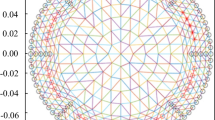Abstract
For the problem that noise has a great impact on the measurement data during the electrical capacitance tomography data acquisition process, a denoising method based on the truncated singular value decomposition combined with the total least squares model is proposed. Soft threshold is performed on the effective value of the truncated singular value decomposition to remove the influence of external noise interference in the measurement data, and as far as possible to retain the original characteristics of the data. For the problem of different errors in the measurement data and the coefficient matrix, a mathematical model is introduced based on total least squares. It is used to improve the total least squares iterative method and reduce both the measurement error and the coefficient matrix error. To solve the problems of slow convergence speed and low efficiency caused by the ill-posedness of the equation during the iteration, adaptive correction parameters are introduced, which effectively avoids the occurrence of local convergence and improves the speed of convergence and imaging accuracy. To solve the ill-condition of the total least squares model, a regularization matrix is added so that the imaging results can achieve the goal of overall optimization. For 12-electrode electrical capacitance tomography system, the simulation experiments are carried out based on four typical flow patterns. The results show that the algorithm effectively increases the robustness of reconstruction and improves the accuracy of the reconstructed images.






Similar content being viewed by others
Data availability
The data used to support the findings of this study are availability from the corresponding author upon request.
References
Almutairi Z, Al-Alweet FM, Alghamdi YA et al (2020) Investigating the characteristics of two-phase flow using electrical capacitance tomography (ECT) for three pipe orientations[J]. Processes 8(1):83–93
Cao BX (2020) A new estimation method of regression parameter applied to the total least squares regression model [J]. J Dali Univ 5(6):1–6
Chen Y, Li H, Xia Z (2018) Electrical capacitance tomography image reconstruction algorithm based on modified implicit formula Landweber method [J]. Comput Eng 44(1):268–273
Chen T, Wang LY, Tang CL et al (2019) Normalized intensity and soft threshold based on SVD denoising method and its application [J]. Modular Mach Tool Autom Manuf Tech 6(8):71–75
Lei J, Liu QB (2020) Reconstruction method with the learned regularizer for imaging problems in electrical capacitance tomography [J]. Appl Soft Comput 89(89):75–98
Li Y, Wang R, Zheng Y et al (2004) Fan beam image reconstruction of optical process tomography based on algebra reconstruction technique [J]. Chin J Sci Instrum 25(5):665–668
Lu L, Tong G, Guo G, Liu S (2019) Split Bregman iteration based reconstruction algorithm for electrical capacitance tomography[J]. Trans Inst Meas Control 41(9):2389–2399
Ma M, He XF, Li M et al (2020) Research on ECT image reconstruction algorithm based on improved TSVD regularization [J]. Transducer Microsyst Technol 39(4):136–139
Naeimi Y, Voosoghi B (2020) A modified iterative algorithm for the weighted total least squares [J]. Acta Geodaetica et Geophysica 55(2):1–16
Qian CJ, Shu GD, Jiang BF (2016) The application of total least squares iterative method in ill posed adjustment model [J]. Modern Surv Mapp 39(4):1–2
Su YC, Wang WY (2019) Analysis of subway testing noise based on SVD differential spectrum denoising method [J]. China Meas Test 45(7):42–45+65
Sun TH (2020) Research on several key problems of ill-posed and robust total least squares method [J]. Acta Geod Cartographica sinica 49(3):398
Tian HJ, Zhou YL (2012) Progress in capacitance tomography technology research [J]. Control Instrum Chem Ind 39(11):1387–1392
Wang H, Yang W (2020) Application of electrical capacitance tomography in circulating fluidised beds - a review [J]. Appl Therm Eng 176:115311
Wang JG, Li J, Liu YY (2014) An improved method for determining effective order rank of SVD denoising [J]. J Vib Shock 33(12):176–180
Wang LL, Chen DY, Yu XY et al (2015) Sensor optimization design in electrical capacitance tomography system[J]. Chin J Sci Instrum 36(3):515–522
Wang YF, Zhu HY, Xiong XY et al (2020) 3D ECT reconstruction algorithm based on adaptive threshold filtering[J]. J Shenyang Univ Technol 42(3):313–317
Wu GM, Lu TD (2019) New methods of ill-posed total least-squares with targeting singular value corrections [J]. J Geodesy Geodyn 39(8):856–862
Xing ZZ, Wu YG, Zhao X et al (2016) Application of singular value decomposition (SVD) de-noising in potential field data[J]. Glob Geol 35(4):1119–1126
Yang T, Chen DY, Wang LL (2018) A novel filtering algorithm of data acquisition for electrical capacitance tomography [J]. J Harbin Univ Sci Technol 23(2):12–17
Zhang LF, Song YJ (2019) Research on adaptive capacitance normalization model for electrical capacitance tomography system [J]. Electr Meas Instrum 56(20):42–46
Zhao Y, Chen G, Jing W et al (2020) Improved SLIC clastering superpixels segmentation method on remote sensing image[J]. J Northeast For Univ 48(11):66–71
Acknowledgements
We thank the anonymous reviewers for valuable feedback. This work is sponsored by National Natural Science Foundation of China (61402126, 60572153, 60972127), Nature Science Foundation of Heilongjiang province of China (F2016024), Heilongjiang Postdoctoral Science Foundation (LBH-Z15095), University Nursing Program for Young Scholars with Creative Talents in Heilongjiang Province (UNPYSCT-2017094).
Author information
Authors and Affiliations
Corresponding author
Ethics declarations
Conflict of interest
We declare that there are no commercial or associative interest conflicts in our work.
Additional information
Publisher’s note
Springer Nature remains neutral with regard to jurisdictional claims in published maps and institutional affiliations.
Supported by National Natural Science Foundation of China.
Rights and permissions
Springer Nature or its licensor (e.g. a society or other partner) holds exclusive rights to this article under a publishing agreement with the author(s) or other rightsholder(s); author self-archiving of the accepted manuscript version of this article is solely governed by the terms of such publishing agreement and applicable law.
About this article
Cite this article
Wang, L., Li, M., Chen, D. et al. ECT for flow imaging: total least squares for image reconstruction algorithm. Multimed Tools Appl 82, 22741–22758 (2023). https://doi.org/10.1007/s11042-023-14520-z
Received:
Revised:
Accepted:
Published:
Issue Date:
DOI: https://doi.org/10.1007/s11042-023-14520-z



